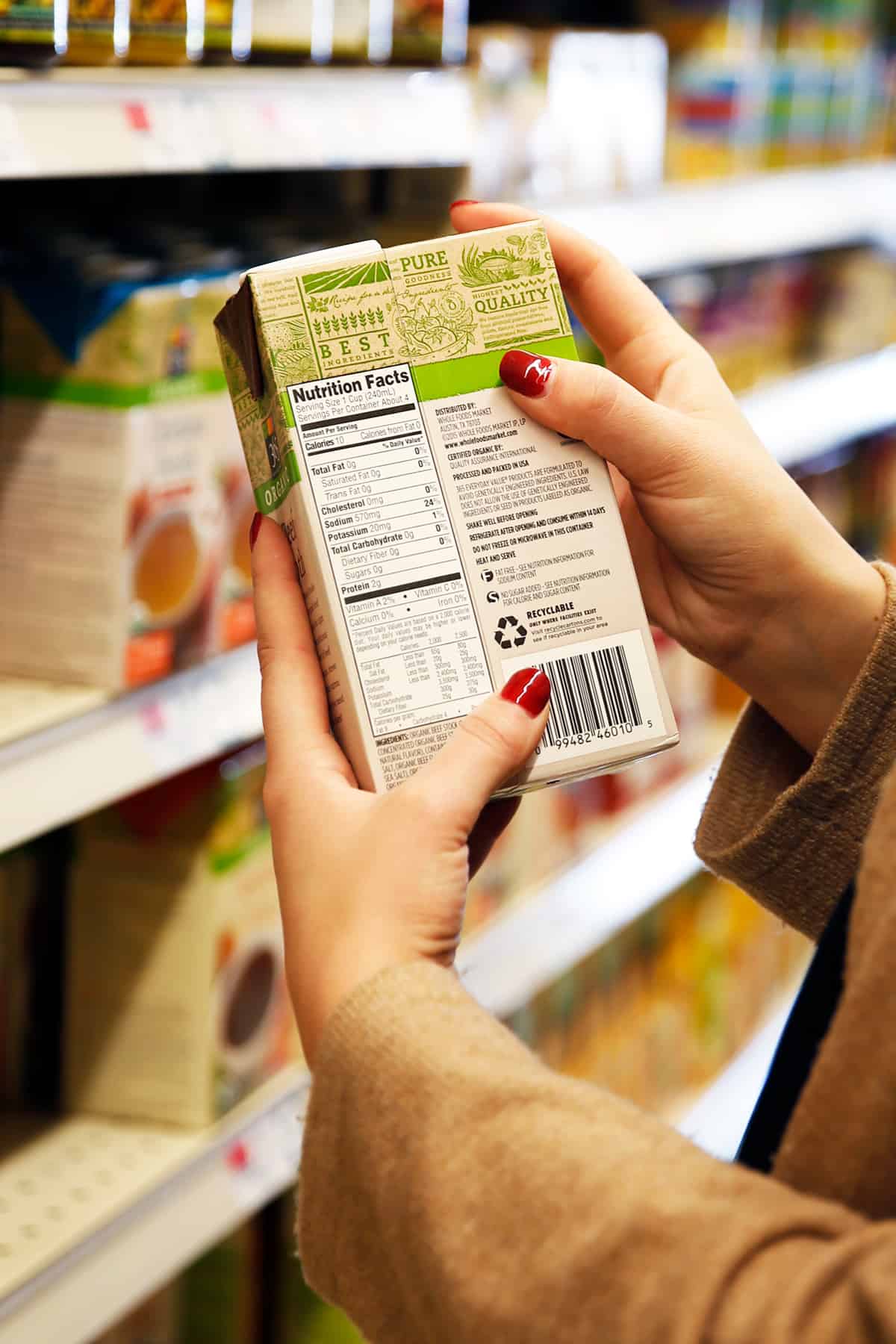This post may contain affiliate links. Please read my disclosure policy.
A nutrition label can be a useful tool to evaluate how healthy (or not) a food can be, but it also can be tricky to truly decode all of the language and facts. Our in-house nutritionist Gabrielle McGrath shows us How a Nutritionist Decodes a Nutrition Facts Label to help you fill your cart with good-for-you products and understand what you’re buying so you can make the best, informed choices!

How a Nutritionist Decodes a Nutrition Facts Label
The key for a successful grocery shopping haul is to be able to quickly and truly understand the nutrition facts label. Knowledge is your best defense when it comes to the products you are adding to your pantry and ingesting in your body. In an ideal world you want to mostly fill your cart with unprocessed whole foods that are not packaged, like fruits, veggies, meats, but obviously it’s important to be able to evaluate the nutrition information on the packaged products.
Product names and health claims put on the front of the package are often misleading and you should be weary. For example, “Low calorie” usually means a chemical sweetener has been added, that “organic” does not mean it is healthy, and that “all natural” means absolutely nothing since there is no strict definition to “all natural.” Advocating for yourself is a necessity.
Some questions to ask yourself when looking at a nutrition label:
- How much daily added sugar is in one serving?
- Is there a high protein content?
- What ingredients are actually in the product?
Below we will go through how to answer all of these questions to help you make the best possible food decisions for yourself and your family!
What is Most Important to Look at On a Nutrition Label
- A short ingredient list looking for minimal ingredients
- Fiber content versus net carbohydrates
- Higher protein versus added sugar
- The percent daily values
How to Understand Food Labels
There are a lot of different components to a nutrition label. Below find out some key pieces that are important to understand.
Ingredients List
Looking at the ingredients list should always be your first priority to make sure they are simple, real, and minimal. Try to choose food with ingredients that sound familiar to you. If you cannot pronounce them, the likelihood is that they are chemicals and/or processed food ingredients, which you want to limit or avoid.
Something to note, is it is arranged by order of amounts, so if sugar is the first ingredient, it’s the majority.
Serving Size
The nutrition facts labels is not reflective of what is in the whole product. It is telling you how much is in ONE serving. A serving is a measurement of food or drink within a product, such as one slice of bread or eight ounces of milk and this fact is dictated by the company creating the product. There are many food products on the market that are a meant to be a single portion but the nutrition fact label says they contain multiple servings.
For example, you may pick up granola see that it has 200 calories with only 5 grams of added sugar. But if your personal serving size is larger than the indicated product serving size, you could end up consumer way more than you intended. If that granola serving size was ¼ cup and you typically have 1 cup of granola, you will be consuming 800 calories and 20 g of added sugar.
Carbohydrates and Fiber…are they different?
Carbohydrates are broken down on the nutrition panel. There are simple carbohydrates that are found in sugars and starches and then there are complex carbohydrates that are found in fiber. This is important when looking at the total carbohydrates to distinguish the two. Net carbs represent the starches and sugars in food after fiber contents have been subtracted.
Net Carbohydrates = Total Carbohydrates – Fiber
Net carbs account for carbs that get digested as sugar and affect your blood glucose while the carbs that come from fiber do not actually get digested and rather aid in good digestion while helping you feel full longer. Women should aim for 25 grams of fiber per day and males 38 grams of fiber per day. When purchasing high carb items try to stick with ones that have 2-3g of fiber per serving.
More Protein, Less Added Sugar
Look for products with a higher protein content than added sugar, especially if it is a snack food that is meant to keep you satisfied if you are feeling hungry between meals. Food manufacturers love adding excessive sugar to their products to make them taste better, especially when masking for “low-fat”. Added sugar can also be disguised as: dextrose, glucose, sucrose, maltodextrin, corn syrup, or high fructose corn syrup.
- The average male is recommended to consume less than 37g of sugar the average women less than 25g. Choose snacks with less than 10g of added sugar.
- The average person should be consuming about .5 grams of protein per lb of body weight. For example if you weigh 200 lbs, you should be consuming about 100 grams of protein per day. Additionally, the more active you are, the greater your protein needs are.
Percent Daily Values (%DV’s)
%DV’s are the average levels of nutrients for a person eating 2,000 calories a day so they should be considered more of a rough estimate. %DV’s are for the entire day, not just one meal or snack. Aim for products low in saturated fat, cholesterol and sodium, with an ideal %DV less than 5%.
Avoid trans fats. You want to avoid trans fat as often as you can because they raise your bad cholesterol levels and decrease your good cholesterol levels. They’re naturally occurring in very small amounts in some dairy and meat products but don’t have the same negative effect as the hydrogenated trans fat in processed foods
Aim for foods high in vitamins, minerals and fiber, with an ideal %DV greater than 20%.
Now that I’ve shared my tips on How a Nutritionist Decodes a Nutrition Facts Label from top to bottom I want to share one more thing: We are all busy and sometimes don’t have time to scan through the entire nutrition label with every item we put in our cart. So if forced to choose one component from the nutrition label to pay attention to, focus on the ingredients list. If you are choosing a coconut cream for various health reasons and then you look at the ingredients and see the first three are water, sugar and vegetable oil then put it down… or you’ll be adding water, sugar and extremely processed oil in your coffee every morning.
The best route is to always choose real food with minimal ingredients added in their purest form!










This post was outstanding! I love how informative it was and love that you broke it down in an easy to read way so I feel confident going shopping and knowing what to look for.
Thanks for the help!
They look complicated but if you know what to look at then it’s easy
This is a great blog with very valuable info. I’m looking forward to hearing more from Gabby
As a mom who is focused on making sure that my family remain healthy, this information is just what I needed to take it up a notch. I will be sharing this information with my family.
Thanks!!
I’m really confused with the Percent Daily Values (%DV’s) suggestion. Aren’t we less concerned with saturated fat and unsaturated fat and more the source of the fat?
Hi Mallory!
Happy to clear this up for you. The type of fat is very important because different kinds of fat(trans vs saturated vs unsaturated) all have different effects on your cholesterol levels. Trans fats raise your bad cholesterol(LDL) levels and lower your good(HDL) cholesterol levels. Saturated fats also raise your bad cholesterol levels, but less than trans fat, and do not have much of an effect on your good cholesterol. This is why moderation is still important. Unsaturated fats, especially polyunsaturated fats, lower your bad cholesterol levels.
Where the fat is coming from is also important! This is because where it is coming from determines how much fat is in it along with what this fat is being paired with in the food product(sodium, sugar, vitamins & nutrients, etc).
For saturated fat specifically, the American Heart Association recommends aiming for for a dietary pattern that achieves 5% to 6% of calories from saturated fat. Hopefully this helped!
So helpful! Will definitely keep this handy next time I’m at the store…. thanks!
I LOVE this blog post! I can’t wait to hear more from Gabby soon! LCK has the BEST team!! 🙂
YAY. She is so awesome and knowledgeable – I can’t wait for you to read more of her articles she has coming!!!